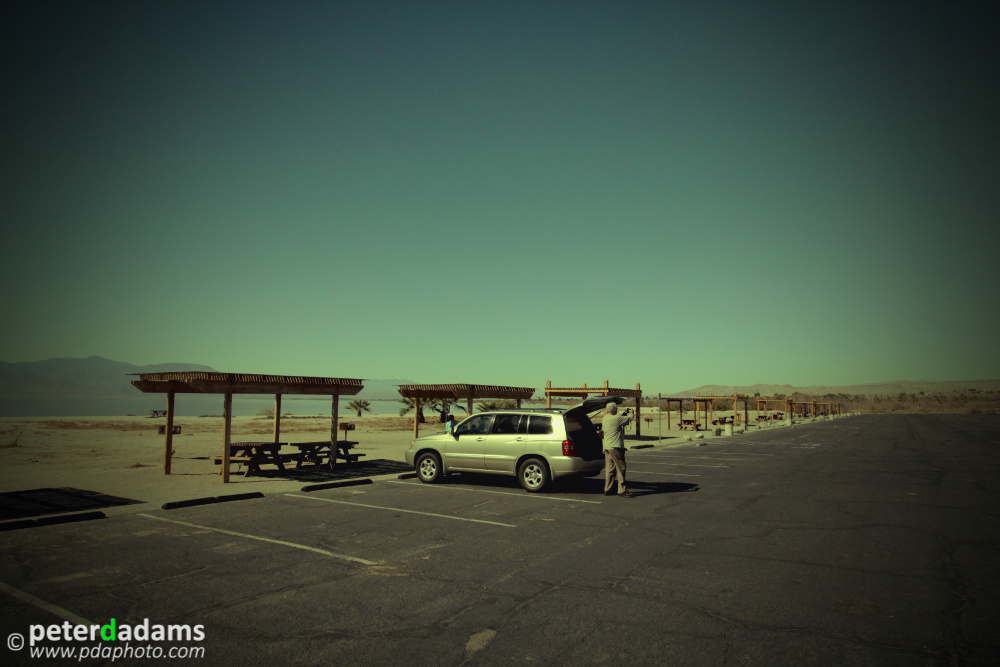When I moved to California in 2008, I had no idea the Salton Sea existed, never mind the history of it over the last 100 years or so.
When I discovered it a year and half later, a little by accident after going hiking in the Mecca Hills/Painted Canyon nearby, I could not believe I had not learnt about it previously. The Salton Sea truly is California’s forgotten place.
Some background about the Salton Sea. Created by accident in 1905 when a flood of the Colorado River overwhelmed the irrigation channels that watered the fertile Coachella Valley, the Colorado River flowed almost unabated for two years into the Salton Sink. The Salton Sink being historically part of the Gulf of California was a dried up seabed, with extremely saline soil. Furthermore, it is the second lowest point in North America after Death Valley with the lowest point being 277 feet (84.5m) below Mean Sea Level. This influx of water into such a low basin meant there was no runoff and thus a large lake formed which today is around 15 mi (24 km) wide and 35 mi (56 km) long; the largest lake in California. The salinity of the sea (caused by salts in the soil dissolving in the water) is around one and a half times higher than the Pacific Ocean and as a result aqua biodiversity of the sea is low, and continues to do so as salinity increases. Today, only Tilapia remain, which feed on the extensive algae blooms caused by agricultural run-off and the incessant heat and lack of freshwater entering the Sea.
During the 1950’s and into the 1960’s, Southern Californians flocked in their thousands to the Salton Sea to enjoy the fishing and water skiing and the ever-sunny weather. Soon many communities started to spring up around the shores catering for the tourists and tempting people to move to the Sea. Projections were made that hundreds if not thousands of people would move to the area. One of these communities, Salton City, on the west side of the Sea was founded and a full street network of paved roads, street signs, and street lights erected, and plots of land put up for sale. During the coming decades, as flooding condemned houses on the shore line, and an increased pollution and salinity started to take hold, it became clear that there were serious problems afoot. Tourists stopped using the Sea for recreation and people failed to buy the plots of land. Many recreation related structures closed up and fell into disrepair, and many of the small communities became near ghost towns. Today, the Salton Sea stands as a monument of accident, mismanagement, and the fickleness of mankind.
My first experience of the Salton Sea was the stench of the place. You smell the Salton Sea before you reach it. A combination of bacterial breakdown, pollution, and mass death of Tilapia fills the air with an overpowering odour that almost makes you gag. As I approached it from the north-east, the first community I came to was North Shore. Several structures were falling down, but there was also a sense of pride of the few remaining homes. The fireman was out polishing his truck, and if it wasn’t for the smell and the odd old signpost pointing to the heyday of the Sea, it could have been anywhere. Just South of North Shore is the Salton Sea visitors centre, where Paradise Remaining was taken. This place was surreal…a parking lot so big it would not look out of place outside the Dodger’s stadium, yet the people running the centre obviously still had hope for people to come and visit. A campsite, restrooms, and new picnic tables, but no visitors! After looking around the visitors centre, and taking in the free 20 minute movie showing, I exited the centre and left back for home thoroughly confused but intrigued by the place, promising I would return. One year later, I did and this time carrying my camera.
On reaching the visitors centre, nothing had changed, except one thing, I had a fellow visitor! On approaching my car to leave and explore some of the communities nearby, I looked up to see my fellow visitor taking a photo (I believe of a passing freight train). The large vacant parking lot and empty picnic area, Salton Sea as a backdrop, and the sharp washed out light somehow reminded me of something familiar but I could not immediately put my finger on it. Taking the shot, I really wanted to capture the loneliness of the Salton Sea and the parking lot, but draw attention to the tourist and the normality of what he was doing without focusing on his point of interest. After returning home and looking at the resulting shot, I started to realize that the image had the quality of a 1960’s tourist vacation shot. I decided that to complete that feeling I needed to infuse the image with a cross-processed look, and a warmth but washed out colour of an image that had been printed 30 or more years ago. The image also reminded me of a photo by a favourite photographer of mine, Nadav Kander, titled Tourist, Monument Valley from his God’s Country series: http://www.m97gallery.com/artist/artists_data/nadav_kander/img/1310108870_1.jpg
Nadav’s image, and mine, share a sense of the great outdoors, and the hugeness of the SouthWest USA. They also appeal to a time when mass tourism and photography became available to the average person. They also have a sense of nostalgia, whether it is for places which were once beautiful but are now overcrowded, or to the family vacations we enjoyed as children for which we only have golden memories, or tangible but fading photographic prints.
Please check out the Salton Sea gallery for more images of the area.
Technical Details:
Aperture: f/10
Exposure Time: 1/1000 sec
ISO: 400
Focal Length: 14mm
Post-process:curves, levels, saturation, vignette

+There are no comments
Add yours